October 12, 2012
Air Date: October 12, 2012
FULL SHOW
SEGMENTS
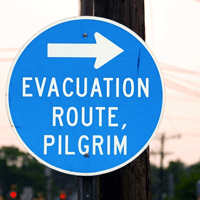
Citizens Sue Nuclear Facility
View the page for this story
A group of Massachusetts citizens is planning to use the Clean Water Act to sue the Entergy Corporation for environmental violations at their Pilgrim Nuclear Power Station. The group says the company should pay nearly a billion dollars in penalties. The citizens' lawyer, Meg Sheehan, laid out the details of the case to host Steve Curwood, and Vermont Law School Professor Patrick Parenteau explained the wider context. (09:45)
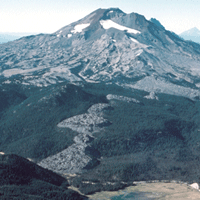
Tapping Volcanoes for Energy
View the page for this story
Scientists are exploring new technologies to harness the power of dormant volcanoes for geothermal energy. David Blackwell, an earth sciences professor at Southern Methodist University, tells host Steve Curwood that volcanoes could power millions of homes. (04:50)
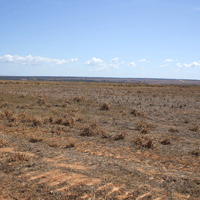
REDD Debate
View the page for this story
Under California's cap and trade plan that starts in November, polluting companies will be able to buy carbon credits from tropical countries committed to REDD, Reducing Emissions from Deforestation and Degradation. Many environmental groups say that can protect tropical forests and reduce carbon dioxide emissions. We revisit a report on attempts to slow Brazil's deforestation by Living on Earth's Bobby Bascomb and Bruce Gellerman. (06:15)
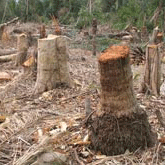
REDD Critic
View the page for this story
California's hope to offset its carbon by buying credits in rainforest nations may not really help, says a recent Greenpeace report. Roman Paul Czebiniak, a Greenpeace Senior Policy Advisor on Climate Change and Forests explains why to host Steve Curwood. (04:50)
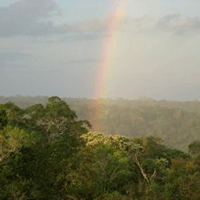
REDD Champion
View the page for this story
Greenpeace's criticism is ill-founded, according to Dan Nepstad. He's executive director of the Amazon Environmental Research Institute, IPAM International, and he told host Steve Curwood that though REDD has a way to go yet, it's the best game in town to protect the forest and cut carbon. (04:45)
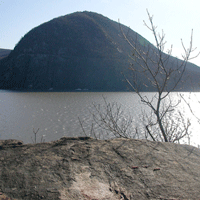
Storm King
/ Jim MetznerView the page for this story
Nearly half a century ago, a remarkable battle over plans to build an electricity pumping station on the Hudson River launched a new branch of the law - environmental law. The facility was planned for Storm King, an iconic mountain known as the gateway to the Hudson Highlands. Producer Jim Metzner recounts the epic story. (15:55)
Show Credits and Funders
Show Transcript
HOST: Steve Curwood
GUESTS: Meg Sheehan, Patrick Parenteau, David Blackwell, Roman Paul Czebiniak, Dan Nepstad
REPORTERS: Bobby Bascomb, Bruce Gellerman, Jim Metzner
[THEME]
CURWOOD: From Public Radio International - this is Living on Earth. I'm Steve Curwood. Some citizens claim a nuclear power plant has damaged the ocean near their homes - they want nearly a billion dollars in damages:
PARENTEAU: This case does represent sort of taking it to a whole ’nother level in terms of using the Clean Water Act against a nuclear power plant. So you can think about a large potential damage award but nothing in the billion-dollar range.
CURWOOD: And they're a long way from their day in court. Also – the battle to stop power plant construction on Storm King.
DUNWELL: It was a mountain that had been painted by the Hudson River School of painters, it was where Geroge Washington had fought major battles to win the revolutionary war - it was a mountain that had incredible significance.
CURWOOD: We'll have those stories and more this week, on Living on Earth. Stick around!
[THEME]
ANNOUNCER: Support for Living on Earth comes from the National Science Foundation and Stonyfield farm.
Citizens Sue Nuclear Facility
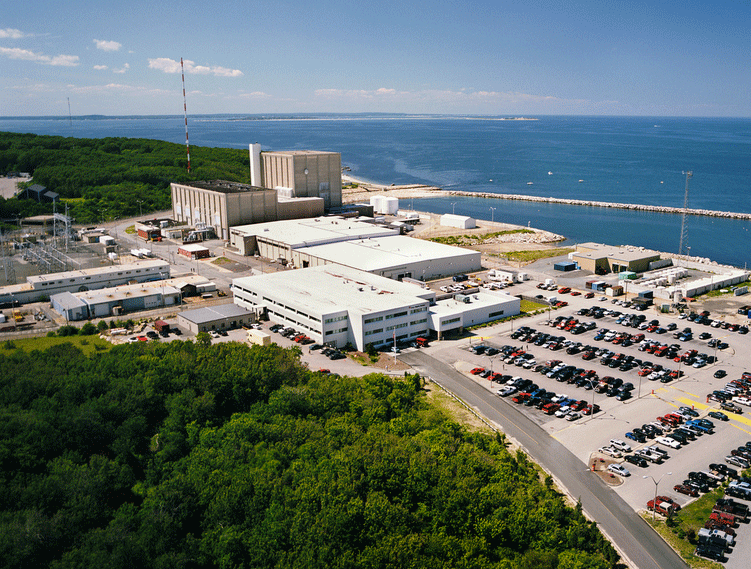
Pilgrim Nuclear Power Station (Entergy Nuclear)
CURWOOD: From the Jennifer and Ted Stanley Studios in Boston, this is Living on Earth. I'm Steve Curwood. A group of citizens has filed an intent to sue the Entergy Corporation, alleging that the Pilgrim Atomic Power Station in Plymouth Massachusetts has violated the Clean Water Act.
They say the plant has polluted Cape Cod Bay, massively killed local fish populations, and the operators kept inadequate environmental records. Entergy could be liable for over 800 million dollars in penalties. Citizens have the right to sue when the government fails to enforce the Clean Water Act so if the EPA does not step in within 60 days, this plaintiff group can proceed. Their lead attorney is Meg Sheehan of EcoLaw.
SHEEHAN: Well, at this point we're alleging they have violated the federal Clean Water Act on over 33,000 separate occasions by discharging pollutants at levels that exceed those permitted in their Clean Water Act permit, and also that they’re failing to adequately monitor and report some of the discharges that they’re dumping out into the bay.
Since about 2000 when Entergy took over Pilgrim from Boston Edison, Entergy has failed to obtain EPA’s approval for their marine monitoring plan. To us that’s a really egregious violation because when Pilgrim was built in the ’70s, there was great concern in the scientific community among the fishermen and the fisheries experts that there would be this terrible impact and these very strict provisions were put in for regulatory oversight. But when Entergy came in, they pretty much told the regulators that they weren’t willing to participate with this oversight advisory committee, so that’s the crux of our allegations.
CURWOOD: How is it that Entergy is killing thousands of fish, you say?
SHEEHAN: First of all, they’ve taken 510 million gallons of cooling water a day from Cape Cod Bay. Any kind of marine life, whether it’s a fish or plankton – anything that can’t avoid this velocity of the pumps gets sucked into the plant – and some of the bigger fish get slammed against these screens and trash racks that they have. The fish are killed either than being impinged and killed on the screens, or they’re sucked in and basically fried. Back in the 1990s, the state Marine Fisheries Department stated that Pilgrim’s operation had killed off up to 40 percent of the winter flounder population.
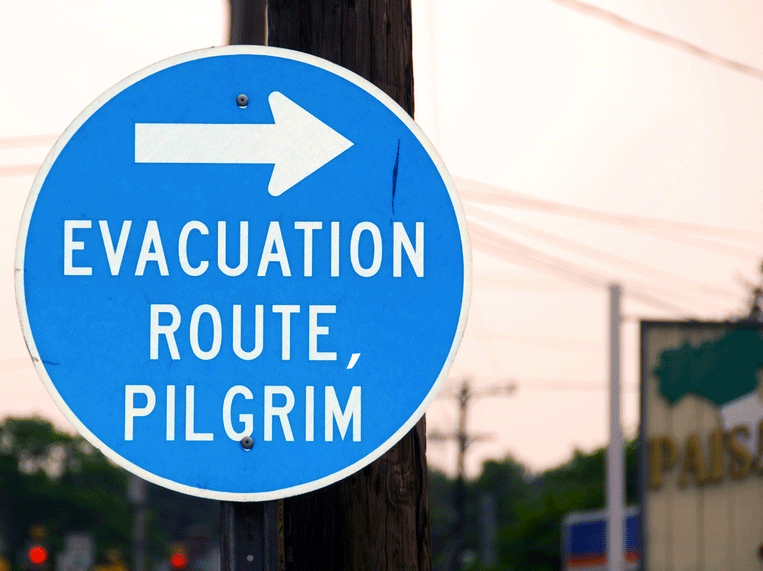
A sign shows the evacuation route from the Pilgrim Nuclear Power Station. (Photo: Timothy Valentine)
CURWOOD: Why did you decide to use the citizen law provision in the Clean Water Act to launch this case?
SHEEHAN: Well, really we had no other option. We’d been talking with federal regulators and state regulators since early this year, urging them to look closely at this, to look closely at these monitoring reports and look at the violations and to review Entergy’s permit which expired 16 years ago to make sure that they were doing the proper monitoring, and no action was taken. This plant is going to be operating for another 20 years from what we understand, so we just felt this was our only option.
CURWOOD: What’s your ultimate goal here - do you want them to clean up their act or do you just want them to shut this nuclear power plant down?
SHEEHAN: I think it’s unrealistic to think that we’d be able to shut it down. We’ve accepted the reality that it has been relicensed by the NRC, and our view is that if it’s going to continue to operate with this kind of environmental destruction, is unacceptable, these kinds of violations are unacceptable, and the EPA really does have to take a solid look at this and update the permit.
CURWOOD: Meg Sheehan is an attorney with Eco Law, thank you so much.
SHEEHAN: Thank you very much.
CURWOOD: Living on Earth contacted the Entergy Corporation seeking comment on the potential lawsuit. Pilgrim Station Spokesperson Carol Wightman sent this statement: “Entergy takes its environmental responsibilities and any allegation of noncompliance seriously. We will respond to the notice of intent after we have had a chance to thoroughly review the specific allegations. We note that EcoLaw unsuccessfully raised a number of these allegations in the NRC license renewal proceeding for Pilgrim Station.”
Well, to assess the wider implications of this case we turn now to Patrick Parenteau, Professor of Law at Vermont Law School. Welcome to Living on Earth!
PARENTEAU: Thank you Steve, good to be here!
CURWOOD: Now, how have citizens used the Clean Water Act to sue nuclear power companies in the past?
PARENTEAU: It’s very rare. Nuclear power plants, of course, are regulated primarily by the Nuclear Regulatory Commission, federal law actually preempts state law, and even preempts the Clean Water Act, when it comes to radiological health and safety issues, so you don’t see very many citizen suits against nuclear power plants under the Clean Water Act. So this case does represent sort of taking it to a whole ’nother level in terms of using the Clean Water Act against a nuclear power plant.
CURWOOD: This group is looking for almost a billion dollars in damages – how realistic is that?
PARENTEAU: Well, I don’t think that’s realistic. I understand the citizens have alleged that because the statutory maximum penalty is over 32 thousand dollars per day per violation, and they’re alleging tens of thousands of violations going back many years. It’s unheard of that a court would actually award such a massive amount of penalties.
It is possible, in these cases, to have penalties over a million dollars. In fact, a group called Earth Island sued the San Onofre nuclear power plant in California back in the ’90s and achieved a 17 million dollar settlement in that case. So you can think about a large, potential damage award, but nothing in the billion-dollar range.
CURWOOD: Who would get the money?
PARENTEAU: Well, it either goes to the United States Treasury, if the court assesses the penalty, or, if there’s a settlement agreement, the plaintiffs, the citizen group, and the plant owner, Entergy, could create what are called environmental credit projects. In fact, there was one done for Boston Harbor many years ago. And these are projects that improve water quality, sometimes they restore wetlands, sometimes they create public education programs, there’s a variety of things that could be agreed to in a settlement agreement – in lieu of a penalty going to the Treasury, the money would go to an environmentally beneficial project.
CURWOOD: Now, I understand that the plaintiffs are basing some of their allegations on the company’s own reports and filings themselves.
PARENTEAU: That’s correct. They’re called discharge monitoring reports, they’re required by law, they’re required to be made public. The courts have said these documents are in the nature of an admission of liability, so that gives the plaintiffs in these cases the upper hand. Now, the real question is going to come down to: do the discharge monitoring reports actually reveal the violations that the plaintiffs have alleged, and that will turn on how you interpret the terms of the permit.
These discharge permits are huge documents with many provisions and conditions and terms. So I anticipate that there will be a lot of argument about what the permit actually requires, and whether the discharge monitoring reports are actually showing a violation or not.
CURWOOD: Now, I know that you don’t have a crystal ball there at the Vermont Law School, but what kind of chance do you think they have for this case?
PARENTEAU: I think they have a chance of either getting a judgment in their favor on some of these allegations, or maybe even more realistically a settlement. The California case, again, comes to mind. In that case, a senior judge in that case was appointed as the quote “mediation judge.”
And these mediation judges have tremendous power to kind of force the parties into a settlement agreement basically saying neither one of you can be sure who is going to win, and you both have a lot to lose, so I am going to meet with you and require that you’d make a serious effort to try to settle your differences. I could see something like that coming out of this case.
CURWOOD: What do you think might be the financial impact of this case on Entergy at the end of the day?
PARENTEAU: Yeah, that’s really hard to judge. It’s not going to be anywhere near the maximum that the citizens are seeking, but I think it could be significant enough that Entergy may reevaluate the economics of the continued operations of a plant like this. These plants, these older plants, are reaching the end of their useful lives, of their economic lives, so a major judgment against them for a water quality violation could tip in the favor of shutting it down earlier rather than later.
CURWOOD: To what extent to you anticipate this tactic being replicated with other nuclear power plants now?
PARENTEAU: Well, there’s a lot of these nuclear plants, the Indian Point plant in New York, the Oyster Creek plant in New Jersey and many others - that are in the relicensing process. They’re older plants, mostly over 40 years old, they probably were not certainly state-of-the-art when they were built, they’ve demonstrated that they had significant impacts on water quality and other environmental conditions, so I guess I would expect more citizen groups located in the vicinity of these plants to be looking for every possibility of either shutting them down, which is happening in some places, or requiring them to install much better technology to protect the environment. So, I think this case may signal - I don’t know if you call it a wave - but this isn’t the last of these kinds of cases that we’re going to see.
CURWOOD: Pat Parenteau is Professor of Law at the Vermont Law School, thanks so much for joining us!
PARENTEAU: You're welcome, Steve!
[MUSIC: The Bad Plus “Seven Minute Mind” from Made Possible (The Bad Plus Music 2012).]
Tapping Volcanoes for Energy
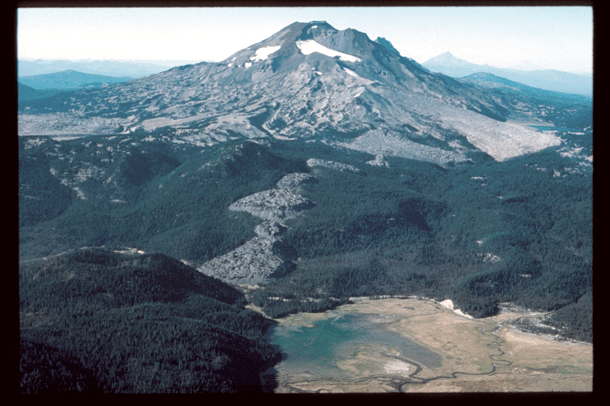
Geothermal energy from the Newburry Volcano in Oregon has potential to power millions of homes in the state. (USGS)
CURWOOD: Well, the problems associated with many forms of energy are giving a boost to novel developments - including enhanced geothermal power. The US Bureau of Land Management has just given permission to tap a volcano in the Cascade mountain range in Oregon. The company Alta Rock Energy will drill into the Newbury volcano - that's been dormant for about 1600 years. David Blackwell is an Earth Sciences professor at Southern Methodist University in Dallas Texas, and a technical adviser on this project.
BLACKWELL: There’s a lot of very hot rocks associated with this volcano, so what will happen is the wells will have to be drilled and then a crack will have to be created between two wells that allows water to be pumped down one well and extracted through the other well after it’s heated up by running through the rock and then the hot water will be separated into steam and run through a turbine to the surface. The water that is produced from that well will be re-injected back into that first well and the cycle just continues.
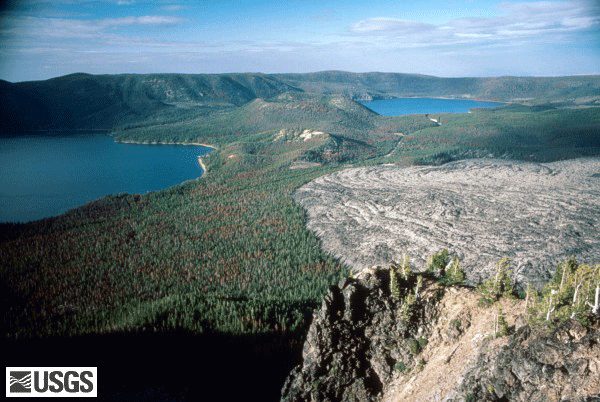
Newburry Volcano (USGS)
CURWOOD: How hot is it down there?
BLACKWELL: It’s about 600 degrees Fahrenheit, so it’s quite warm.
CURWOOD: Now, how safe is this? I mean, drilling cracks into rocks in an area that’s inherently unstable… it seems like risky business. It kind of sounds like hydraulic fracturing to get natural gas.
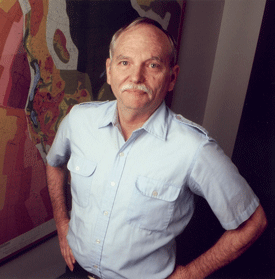
David D. Blackwell
BLACKWELL: The process is very similar to the fracturing that they use to get the gas shales. But, in particular, with geothermal, there’s been a number of high-level studies to determine how to do this in the best, safest way, and how to monitor it to make sure the process doesn’t cause some kind of a problem.
CURWOOD: Now, I understand that the Newbury volcano is on Bureau of Land Management land, that’s federal land, and the Bureau has now given the green light to start drilling these wells. So what might be the danger to wildlife in the area?
BLACKWELL: The actual site of the well is in a clear-cut section, so this is not an area that is extensively used by the wildlife.
CURWOOD: And how much infrastructure is involved?
BLACKWELL: Very little. In fact, on the drill pad, which occupies, I think, about five acres, and all of the equipment will be on that pad. There’s a road, but the roads are already built because of the timbering - there’s extensive timbering on this side of the volcano.
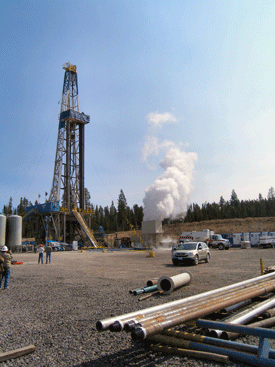
The original drilling of the well that will be stimulated by AltaRock when it was drilled in 2008 by Davenport Energy and was being tested. There is a wisp of steam coming from the well in the separator to the right of the well. The white truck is preparing to run an instrument down the well to measure the temperature.
CURWOOD: So what’s the potential here? How much energy do you expect to get from the wells at the Newbury Volcano when it’s up and running?
BLACKWELL: We estimate that there’s potentially about 2,000 megawatts of power that could be developed. And that’s enough to basically run a city of a million people.
CURWOOD: What’s the potential for hot-rock energy for the United States?
BLACKWELL: The potential is immense, because once we can develop the technology, then we can make accessible areas which were not previously utilizable from geothermal power. So this could really increase, by orders of magnitude, the amount of geothermal power that the United States could develop. Right now there’s on the order of 3,000 megawatts, but it could easily go to 10 to 20 times that number.
CURWOOD: So, professor, how benign is this form of energy compared to the other choices we have out there? I think of burning coal, I think of nuclear power, I think of solar and wind.
BLACKWELL: Well, compared to solar and wind, geothermal is considered baseload. So, geothermal can operate 24 hours a day, 365 days a year, whereas both solar and wind are very intermittent, so they require other types of power to supplement them when the sun isn’t shining or the wind isn’t blowing. Compared to coal, geothermal is extremely clean, there are no emissions. The technology would be somewhat similar to the shale gas. But of course, again, burning gas generates CO2, but not nearly as much, it’s not nearly as polluting as coal.
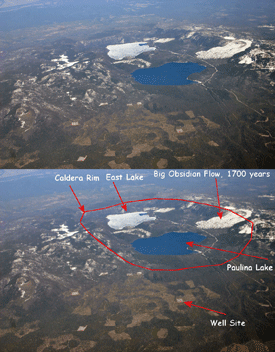
Newberry caldera
CURWOOD: And compared to nuclear?
BLACKWELL: In nuclear, one has to look at the whole sequence of power source, from the mining, which generates pollution, because you’re opening up the ground which has radioactive materials, potentially subjecting that to groundwater, you’re refining it, but then when you’ve spent the fuel… we still don’t know what we’re doing with all of this waste fuel. So nuclear has a whole series of very complicated problems that have to be dealt with.
CURWOOD: This enhanced geothermal system sounds too good to be true! No pollution, all the steam you could need - you could power millions of homes with it… what’s the catch?
BLACKWELL: The catches are two: one we haven’t done it, and two it’s going to be probably a little bit more expensive than most of the other sources, with perhaps the exception of nuclear. But that’s why it’s important for there to be some support for the research of this type, because we need to find out if this is a source which we can develop, because it can have a very, very significant impact on a lot of factors dealing with energy in the United States.
CURWOOD: David Blackwell is a Senior Professor of Earth Sciences at Southern Methodist University. Thank you so much, sir.
BLACKWELL: Thank you!
Related links:
- Alta Rock Energy
- MIT Study on the Future of Geothermal Energy
[MUSIC: Art Blakey “Lee’s Tune” from Drums Around The Corner (Blue Note Records 1959)]
CURWOOD: Just ahead – Greenpeace says California's dreaming - of carrying on polluting AND protecting the rain-forests. Stay tuned to Living on Earth!
[CUTAWAY MUSIC: Thelonious Monk: “Monk’s Dream” from Monk’s Dream (Columbia Records 1962).]
REDD Debate

Once Amazon rainforest, this land is now cleared and ready to be planted with soy. (Photo: Bobby Bascomb)
CURWOOD: It’s Living on Earth, I'm Steve Curwood. REDD – the UN plan to reduce emissions from deforestation and degradation – is an attractive idea: have rich countries pay tropical forest nations to keep trees standing and soaking up carbon.
With the international Kyoto Climate Treaty stalled, Norway has done some REDD deals on its own in Brazil and Indonesia, and now California is getting ready to follow suit.
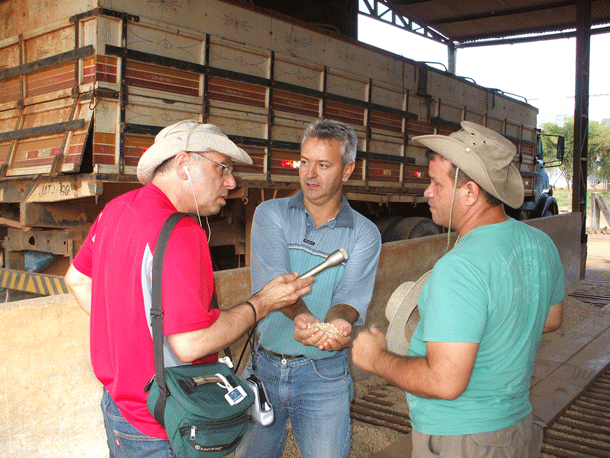
Soy farmer Jamar Brunier (center) with Bruce Gellerman (left) and Marco Lima (right) (Photo: Bobby Bascomb)
Critics of these efforts include Greenpeace. We’ll have more about California’s REDD plans just ahead, but first back to 2009. Living on Earth's Bruce Gellerman and Bobby Bascomb traveled to the Amazon to see tougher enforcement of forest protection in action. Along with their translator, Marco Lima, Bruce and Bobby met with John Carter, who's trying to ranch responsibly. Here's a portion of their report.
[PARADE SOUNDS AND MUSIC]
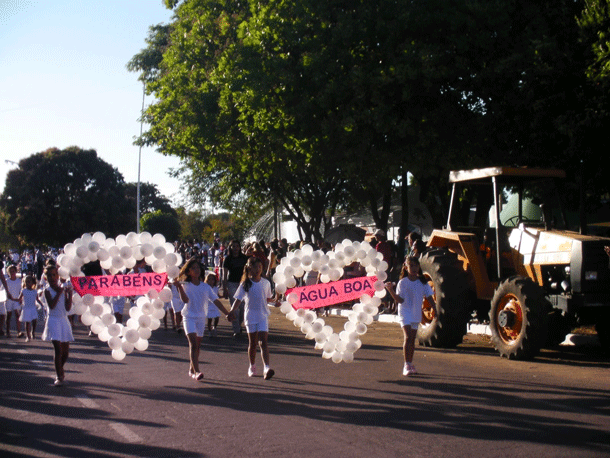
A parade in Agua Boa, Brazil’s beef growing heartland. (Photo: Bruce Gellerman)
BASCOMB: Marching bands commemorate the 30th anniversary of the city of Agua Boa. The boom town lies in the geographic heart of Brazil at the center of cow country. The place is perfect for agriculture: flat as Kansas but four times as large. What was once a forested frontier is now on the cutting edge of Brazil’s future, and fertile territory for John Carter and his Allianca de Terra – the Land Alliance.
[DRIVING SOUNDS]
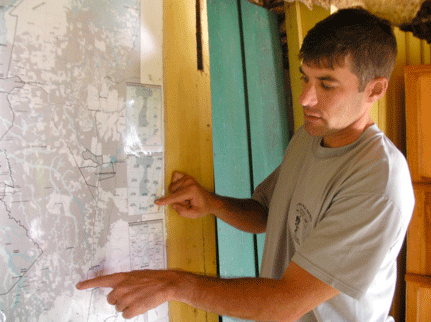
John Carter pointing to his region of Brazil on a map. (Photo: Bruce Gellerman)
CARTER: Look over here, off to the east over here at around 11:00 - all that's our forest reserve.
BASCOMB: Carter drives us around his ranch. In this part of the Amazon, you’re supposed to keep half your land forested, but few follow the law. When Carter bought the place he decided to let 22 hundred acres regrow. He says that choice cost him more than a million dollars in lost productivity.
CARTER: And I let it come back to forest to come into compliance with the forest code.
BASCOMB: Do you regret doing that?
CARTER: I don't regret it, no. Personally I don't, but it was not a very wise decision. I don't get paid anything. I should be getting paid carbon credits for that. Two to three tons a year per hectare that's sequestering – that's a pretty good revenue stream for the ranch.
BASCOMB: The experience made John Carter one of the biggest cheerleaders for a REDD mechanism in Brazil. He founded the Land Alliance, and after convincing ranchers he wasn’t a CIA agent, signed up 160 Amazon farmers proving they could do better financially by doing good environmentally.
CARTER: We want to create mechanisms that puts a carrot out in front of the producer instead of a gun barrel behind his head.
BASCOMB: Since cattle are the force driving deforestation in the Amazon the Land Alliance hopes to put consumers in the driver’s seat.
GELLERMAN: Carter’s Land Alliance is creating a premium brand of beef, guaranteed not to come from deforested land, for which consumers would pay a premium price. In effect, a REDD mechanism for red meat. His organization has devised a vigorous certification system for member farmers.
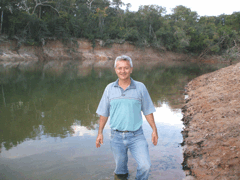
Farmer Jamar Brunier stands in a river that runs through his property. When colonists first settled the frontier the Brazilian government encouraged them to deforest all the river banks to reduce malaria. Now Land Alliance farmers like Jamar Brunier are reforesting riparian zones. (Photo: Bobby Bascomb)
CARTER: So he’s coming into our system, he’s taking off his clothes basically, he’s showing us his body and all the defects, and he’s allowing us to tell him what he needs to do to come back into compliance.
GELLERMAN: So the idea is to make the value of a standing forest more valuable than if you were going to cut it down and use if for cattle, soy beans, and so on?
CARTER: Absolutely. Our goal, hands down, is to buy time. More importantly, is that long-term goal, like you said, to make the standing forest at least almost comparable in value to the cleared forest. If it’s 30 percent as valuable as the cleared forest, we’re gonna have a tremendous impact. Doesn't have to be one to one. People sense that there’s a lot of goodwill and a lot of people that are willing to create a new model.
[BIRD SOUNDS]
GELLERMAN: Jamar Brunier is one of those people. Recently, Brunier joined Carter’s Land Alliance. 20 years ago, he and his wife migrated from the south of Brazil to Mato Grosso. They came with one suitcase each and a shared dream. Today, they own a grainery and 65 hundred acres of land.
BRUNIER: [Translation] When I bought this land I didn’t have any information from anyone. I simply came with a Caterpillar and we cleared everything here. Come look down here.
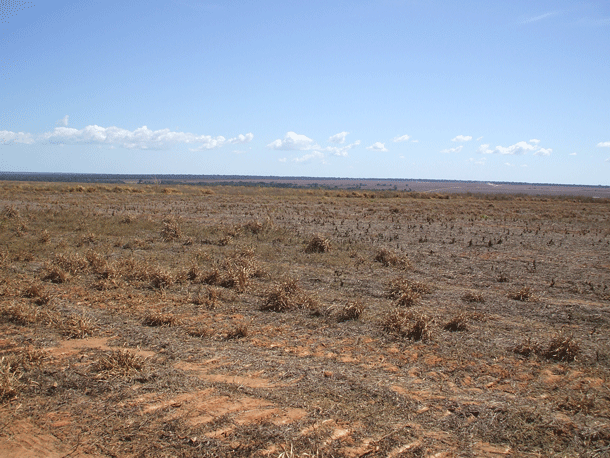
Once Amazon rainforest, this land is now cleared and ready to be planted with soy. (Photo: Bobby Bascomb)
[WALKING SOUNDS]
BRUNIER: [Translation] We simply cut, chopped down everything all the way to the river banks.
GELLERMAN: Land Alliance evaluators scrutinized satellite photos and visited Brunier’s farm. They found he had destroyed a thousand acres too much. They gave Brunier a report detailing what needed to be done and the technical expertise to come into compliance. More carrot, less stick.
BRUNIER: [Translation] Now with the help of the alliance they came here and told us what to do and before the government comes here and fine me, I’m going to start to replant with the original woods from here. I will do the reforestry.
GELLERMAN: Would you have known that without the Land Alliance?
BRUNIER: [Translation] No, I was going to be fined by the government such a fine that I would never have money to pay. I was going to go bankrupt.
[BIRD SOUNDS]
GELLERMAN: But these days it’s not the government that worries farmer Jamar Brunier the most – it’s a non-governmental organization: Greenpeace. The NGO’s scathing report “Slaughtering the Amazon” blames farmers like Brunier for destroying the forest.
BRUNIER: [Translation] If NGO’s come here to accuse us, what are they going to do? We’ve been doing things right. I will tell Greenpeace my water is clean.
GELLERMAN: What would you like to tell Greenpeace?
BRUNIER: [Translation] I really want to tell the guys from Greenpeace that they need to know from where the food come from – from where the butter comes from, where the food their kids eat comes from. And I cry because no one comes to hear us what we want to say. They only come here to spank us. That’s why I’m crying.
BRUNIER: [Translation] Our intentions are good.
GELLERMAN: Says Amazon farmer Jamar Brunier.
[MUSIC: Jose DaLouis Alenca, recorded on location in Para Brazil by the LOE producers.]
CURWOOD: Bruce Gellerman and Bobby Bascomb in Brazil in 2009. Well, that farmer, Jamar Brunier, might have another beef with Greenpeace today. The organization has long promoted conservation but it recently criticized sub-national REDD projects in a report called, “Outsourcing Hot Air.” Greenpeace says these REDD projects may do little to cut pollution.
Related links:
- Greenpeace Report “Outsourcing Hot Air.”
- Dan Nepstad’s Response to the Greenpeace Report
- Listen to the Entire REDD Documentary from Brazil
- Norway’s International Climate and Forest Initiative
REDD Critic
CURWOOD: From November, California will phase in a state-wide cap and trade system that allows polluting companies to buy carbon offsets from REDD projects in the developing world. Roman Paul Czebiniak is a Greenpeace Senior Policy Advisor on Climate Change and Forests. He says the problem with the California plan is one of scale.
CZEBINIAK: We’re very much in favor of financing forest protection at many different levels. Our issues is with the push for including sub-national forest offset projects into the carbon markets in a way that would allow industrial polluters to continue to emit in California and elsewhere.
CURWOOD: What’s the downside of letting large carbon polluters in California buy some offsets?
CZEBINIAK: There are three key problems. And the first is that sub-national forest offsets that are being considered here have not been proven to deliver real additional emission reductions. So, if you’re exchanging fake reductions for real reductions, you’re actually making the climate crisis even worse. I think the second problem - studies at Stanford University and elsewhere have shown - that the sub-national offset approach could actually do more harm than good by creating a disincentive to national-level reductions in different sectors.
And, finally, the markets are very good at delivering a specific commodity at the lowest possible cost. And in the framework of forests, you’re dealing with very complex ecosystems, which have people who have lived there for millennia, and rich biodiversity, and foods for the planet. So the risk is that by focusing on the forest, you could lose the forest for the trees.
CURWOOD: Now, REDD projects have to go through many rounds of verifications and certifications before their carbon credits are ever allowed on the market. How satisfied are you with the results from that level of scrutiny or do you see problems with the quality of these projects?
CZEBINIAK: Well, you’re certainly right to point out that there are many voluntary standards out there, there are many verification bodies out there, but complexity is not a sufficient substitute for accuracy. If you’re claiming emissions reductions, how do we know that those reductions are real, rather than just business as usual?
CURWOOD: The Greenpeace report looks at a forest carbon project in Chiapas, Mexico as a case study. Can you tell me what you found there?
CZEBINIAK: Sure. Greenpeace sent a team to investigate the REDD program in Chiapas to see whether or not its delivering on its claim of emissions reductions. And what we found is a significant lack of transparency in what is being promoted. Among other things, no baseline has been established, so we don’t know whether or not it’s achieving additional emissions reductions or whether it’s just business as usual. Since there’s no national applicable monitoring program, there’s no way to know whether it’s actually reducing deforestation, or whether it’s simply displacing deforestation to another part of the country.
CURWOOD:Let me ask you a basic philosophical question of Greenpeace… the Kyoto Protocol calls for national-level trading of emissions. How does Greenpeace view the national-level trading emissions to begin with?
CZEBINIAK: Greenpeace isn’t opposed to carbon trading on any philosophical level. But when we look at the world’s largest offset market, the Clean Development Mechanism, it contains many lessons that we should consider when we’re looking at the issue of REDD in California. One of these issues is: are we creating a disincentive national-level to reduction of emissions by giving countries credit for doing something on a much smaller scale.
CURWOOD: So, some in Greenpeace would say that all of the participation that China has had in the Clean Development Mechanism of the Kyoto process, that that’s for nought?
CZEBINIAK: Certainly seems to be the case, that this CDM has provided a active disincentive for China to take action on climate change. Look, China has so far opposed action, precisely because it gets money and credit for doing something on a much smaller scale. We’re concerned that the same thing will happen with REDD. We have an international climate change agreement where countries have committed to taking action on a national-level. And what California and others are pushing for is for those countries to do something that is significantly less.
CURWOOD: Roman Paul Czebiniak is a Senior Policy Advisor on Climate Change and Forests at Greenpeace International.
REDD Champion
CURWOOD: But the Greenpeace report didn't go unchallenged; Dan Nepstad defended the California plan in the online magazine Monga Bay. Nepstad is executive director of IPAM International - that's the Amazon Environmental Research Institute. He says REDD at a national level is still a long-term goal but it will be a while in coming.
NEPSTAD: So in the interim while we’re still waiting for this grand global
scheme to come together we’ve got to be very pragmatic and look for any opportunity that we can to get positive recognition and benefits flowing into these states and provinces that have done amazing things in lowering greenhouse gas emissions from deforestation and forest degradation.
CURWOOD: The Greenpeace report, they call it “Outsourcing Hot Air”, is saying that the sub-national REDD projects won’t actually reduce greenhouse gas emissions. They say polluters in California, in this case, will still be able to go on polluting.
NEPSTAD: California’s international offset mechanism would actually be the first market mechanism that rewards states and provinces around the world that have already reduced global greenhouse gas emissions by 1.5 percent. And they’ve received virtually nothing for that. This is the type of transformation that California’s offset system could leverage, could catalyze. If California drops this piece of its legislation, the chance of procuring these gains, and deepening these gains for the climate and for rain forests will be greatly diminished.
CURWOOD: How does the reduction of emissions, attributed to REDD, compare to what’s happened under the Kyoto Protocol?
NEPSTAD: Believe it or not, even though REDD doesn’t actually have a fully formed international mechanism, we’ve had about one and a half billion tons of emissions reductions just from the states of the Brazilian Amazon. Compared to 1.9 billion tons in the European Union nations that are participating in the Kyoto Protocol. So these states and provinces of the tropical nations have achieved incredible reductions in emissions. 1.5 percent of all of the emissions of human activities released into the atmosphere have been produced, basically, voluntarily by these states and provinces. And it’s this context that preserving this element of international offsets within the California policy, is incredibly important to send the signal to these political leaders that what they’ve done is recognized, and will be rewarded.
CURWOOD: What do you think motivates Greenpeace in its criticism? They use very strong language, and I’m quoting here, that they “risk finite resources on a policy mechanism that will not deliver real benefits for the climate, forests or people, and could even make matters worse.”
NEPSTAD: In my opinion, this report is poorly informed. I think this is a lack of understanding, really, of the processes that it’s criticizing. We do have to be careful with offsets. As we see with the Clean Development Mechanism of the Kyoto Protocol, some of these mechanisms do not give us climate benefits, they do not really add up to robust reductions in greenhouse gas emissions to the atmosphere, even though the money is flowing through these mechanisms and we need watchdog groups like Greenpeace doing just that. In this case, though, I think that they missed the mark.
CURWOOD: Dan Nepstad, what do you think is the real potential of REDD to deliver on its promises to protect rainforests, to preserve biodiversity, and to reduce greenhouse gas emissions?
NEPSTAD: Steve, that’s the quintessential question. We think that REDD is the first step towards a much larger shift in the way that we grow food and livestock and fiber and feed and fuel around the world, that basically retools the economy so that those economic transactions and activities that are eroding the natural capital of the planet, will make less money because we’re building in the environmental externalities into those transactions.
It this recipe, it’s this new development model that we think could eventually, by 2020, reduce emissions by as much as 10 percent. This is, for me, one of the great sources of optimism today.
CURWOOD: Dan Nepstad is Executive Director and Senior Scientist at IPAM International, part of the Amazon International Research Institute. Thank you so much!
NEPSTAD: Thank you very much Steve!
[MUSIC: Victor Wooten “Love Is My Favorite Word” from Sword And Stone (Vix Records 2012).]
CURWOOD: Coming up – looking back nearly half a century to an environmental landmark:
[MONTAGE OF KENNEDY/KING, CLIPS FROM UNIVERSITY OF ALABAMA SHOOTINGS 1963, BEATLES, PETE SEEGER…]
Storm King
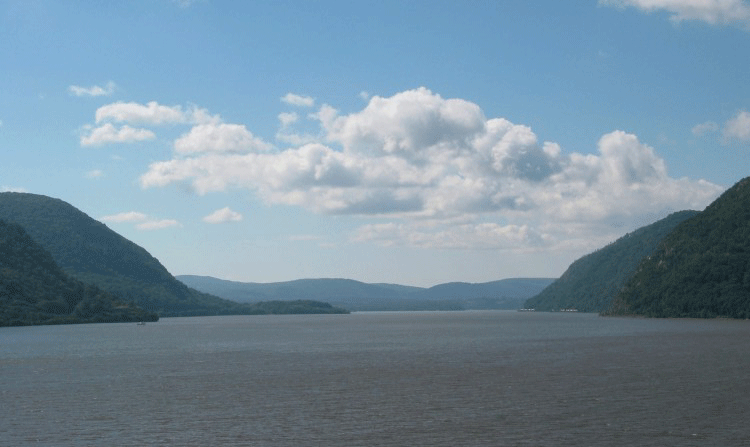
Storm King Mountain on the Hudson River. (New York State Department of Environmental Conservation.)
CURWOOD: It's Living on Earth - I'm Steve Curwood. It all began back in 1963 - when the utility company, Consolidated Edison, announced plans to build a power plant facility on the iconic Storm King Mountain to supply New York's growing energy needs. What it launched was a full-scale environmental battle to save this gateway to the Hudson Highlands, so treasured and so often painted by artists - think Thomas Cole and Frederick Church.
The campaigners drew on the tactics the NAACP developed for the civil rights movement, and helped launch a whole branch of environmental law. "Storm over the Mountain" presents this epic history. It's part of The Sound and Story Project, mixed and narrated by Jim Metzner.
METZNER: Consolidated Edison was the major energy company serving the New York metropolitan area. In April 1963, they published a drawing of the proposed new state-of-the-art plant. ConEd boasted that the plant would satisfy all of New York City’s growing energy needs. But instead, something happened that nobody could have predicted.
[MUSIC]
METZNER: ConEd applied to the Federal Power Commission for a license to build a plant. ConEd, in those days, was as much a part of the industry as the utility companies they were supposed to regulate. So much so that when the chairman of ConEd announced the project he said, “no difficulties are anticipated.” Besides, ConEd was proposing a plant on the Hudson, a river whose pollution was legendary.
[NEWS CLIP: “Here’s Johnny!” CARSON: But seriously, pollution on the Hudson is really bad! I saw a fisherman the other day, he turned his back for a minute and his worm made a break for it! (laughter)]
DUNWELL: Slaughterhouses dumping chicken parts into the river and blood and guts!
METZNER: Fran Dunwell, Coordinator of the Hudson River Estuary Program, grew up on the river.
DUNWELL: Communities were dumping raw sewage into the Hudson. Industries were dumping industrial chemicals. It was just an industrial canal!
METZNER: Powerplants along the Hudson were not new. ConEd’s nuclear plant at Indian Point was just 38 miles north of New York City. But this would be the first hydro-electric pump storage facility.
DUNWELL: So the idea for the power plant was that they would pump river water up the mountain to a reservoir at the top.
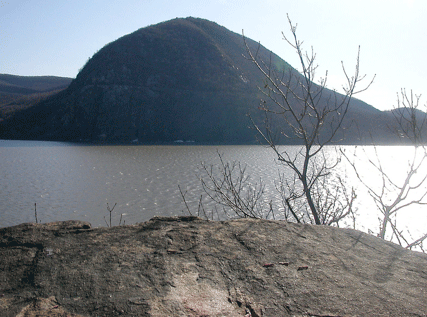
Storm King Mountain. (Photo: Schezar)
METZNER: That’s 8 billion gallons up a two-mile long tunnel 40-feet in diameter.
[SOUNDS OF WATER]
DUNWELL: They would pump it up at night, when there was low demand for electricity, and they would release it from the mountaintop reservoir, down through turbines, back to the river during the day, during peak demand.
METZNER: Those 8 billion gallons of water would sit in the mountaintop reservoir, functioning like a huge storage battery. Then the water would be let loose, surging through the tunnel, turning giant turbines generating electricity for New York City.
[WATER SOUNDS]
[MUSIC FROM ELECTRICITY AD]
DUNWELL: Everybody went electric, right? In the ’50s and ’60s, everybody’s buying electric appliances. They’re putting electric heat in their house. This is all basically happening during the day. Then at night, everybody goes to sleep - they turn off the dryer, they turn off the dishwasher, they turn down the heat and there’s a low electric demand.
METZNER: It would take more energy to pump the water up the hill than the facility would actually produce, but it worked because they pumped the water up at night when their energy costs were low. And then they released the water during the day when demands for energy were high, and they could charge more for it. You have to admit, it was ingenious.
DUNWELL: No question about it, it was the wave of the future, that’s what everybody was doing. If you wanted to be top of your game in electric power, that’s what you would propose! Here you had this big river full of water, mountains on both sides, just the right height, just the right size.
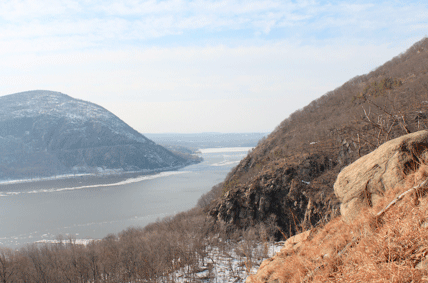
Storm King Mountain on New York’s Hudson River (Photo: Joseph B)
METZNER: The mountain was Storm King, 1,350 feet high, about 50 miles north of New York City, and it stands like a sentinel guarding the entrance to the Hudson Highlands and some of the most celebrated scenery in the world.
DUNWELL: It was a mountain that had been painted by the Hudson River School of painters, it was where George Washington had fought major battles to win the Revolutionary War, it was a mountain that had incredible significance and that was the mountain that ConEd chose for a power plant.
METZNER: So, in May 1963, ConEd proudly announced in its annual report their plans to build the largest of its kind, state-of-the-art pump storage facility. They also published an image.
[MUSIC]
METZNER: Betsy Pew was a Hudson Valley resident and early grassroots organizer:
PEW: And then everyone stepped back and said: “Good heavens! What is this?”
DUNWELL: They were aghast. You know, it was… how could you scar Storm King mountain?
PEW: They just took the whole side off the mountain, and people were shocked.
DUNWELL: There was no going back from that.
PEW: They published it with all great pride.
DUNWELL: When people saw this they said: we can’t let this happen.
METZNER: The beloved mountain looked like a set for a science fiction movie, a huge chunk was carved out of its side to house the power plant with a transformer and switch yard in plain view from the river.
DUNWELL: So a handful of people got together and said: we have to form a coalition of people to fight this.
METZNER: They called themselves the Scenic Hudson Preservation Conference. A group of 12 diverse people who had in common their passion for the river’s history and beauty.
DUNWELL: And they realized that ConEd was going to have to get a license from the Federal Power Commission, and that would be the only avenue they might have to raise legal issues and fight the project.
METZNER: And so Scenic Hudson challenged ConEd’s request for a license. The Federal Power Commission or FPC agreed that the scenic value of the Hudson Highlands was great; the public’s need for electric power, however, was greater. In 1964, ConEd’s plans to build an electric power plant on the face of Storm King mountain were approved. And a license was granted.
But the case had also caught the attention of Bob Boyle, a writer from Sports Illustrated and an avid fisherman. Bob had explored every nook and cranny of the Hudson and knew first hand that the polluted river was still home to millions of fish that fed the entire east coast fishery. Bob was passionate about the Hudson and he liked a good fight.
[MUSIC]
METZNER:During the FPC hearings, ConEd expert Dr. Alfred Promutter (sp?) guaranteed that there would be no impact on fish eggs and that the spawning grounds for striped bass were much further up the river. He also claimed that no study had been done on the Hudson River fishery since 1936. But Bob Boyle obtained a copy of the scientific paper on the Hudson written in the ’50s, and so tracked down the authors of this paper.
BOYLE: I said, “I have this paper that you did, in which you found that striped bass spawn right in the vicinity of Storm King Mountain.” He said, “That’s right.” I said, “Well Dr. Alfred Promutter..” He said, “Al Promutter?” I said, “do you know him?” He said, “Know ‘em? He hired us! He was in charge of the survey!” I said, “Oh ho ho!”
METZNER: The fact that Storm King Mountain was the location of a striped bass spawning ground wasn’t the only thing that ConEd’s expert witness got wrong. Bob Boyle also knew that pumping eggs, larvae, and young fish up a mountain and then shooting them down through a whirl of turbine blades would devastate the fish population.
BOYLE: How would you like it if I said, “I’m going to shoot you up in an elevator at 100 miles per hour and I’m going to shoot you down again, and I don’t know how it’s going to stop on the first floor.” That’s the essence of what was going on with the fish!
METZNER: Dr. Promutter had estimated that only 3.6 percent of the fish in the Hudson would be killed. But he left out one thing - the Hudson is a tidal river.
BOYLE: What’s critical about this is that if you had striped bass eggs in the Storm King area, they just don’t go past the intakes that suck up the water once, they go past it 10 times. And so, instead of the phony formula that the state and ConEd concocted that said that 3.6 percent of the fish could be killed, it was 36 percent.
METZNER: To support this claim, someone had taken photos of massive fish kills at ConEd’s Indian Point power plant down the river, photos that mysteriously disappeared. Feeling like a character in a spy novel, Bob Boyle tracked down the photos from two men associated with the conservation department.
BOYLE: I said, “How do you happen to have the pictures?” They said, “Well, you know, our superiors came to us and said we want the pictures you have.” So they took the pictures, and then they came back a month later and they said, “We want any duplicates you have.” So we gave them the duplicates. I said, “Well, how do you have this?” They said, “They didn’t ask about triplicates!”
METZNER: The case had also caught the public’s attention. The growing threat of urbanization was changing the American landscape. Rachel Carson’s book “Silent Spring” exposed the danger of pollution. A belief in the power of the common person to organize and fight large corporations was fueling massive demonstrations.
[MUSIC]
METZNER: Scenic Hudson grew from a small group of concerned citizens to an organization with members from all over the country and the world. They organized protests with letter campaigns, but the main fight remained on the legal battlefield. They hired a prominent law firm to appeal the decision to license the plant. Albert K. Butsel (sp?) was one of the attorneys assigned to the case.
BUTSEL: I would describe myself at that point as a very frightened first-year associate.
METZNER: The case was heard in October of 1965. ConEd argued that Scenic Hudson did not have the right to sue, it lacked what in legal terms is called ‘standing’. In order to initiate a lawsuit, you have to have some sort of economic interest.
BUTSEL: You can’t just be a citizen who cares about it - you have to have some kind of legal interest. And historically, legal interest has been associated with property ownership.
METZNER: Well, Sceneic Hudson was a group of citizens without any financial interest in power plants or the mountain. Nevertheless, they persisted and asked the FPC to demand that ConEd do a better job at reviewing alternative ways to provide electricity to New York City, and investigate further the threat to the Hudson’s fish.
BUTSEL: And when the argument was over, I thought we had a 25 percent chance.
METZNER: While Scenic Hudson waited for the court’s decision, something unexpected happened:
[NEWS ALERT: MASSIVE POWER FAILURE IN THE EAST]
BUTSEL: Then on November the 9th, the lights went out in New York, it was the great black out of 1965, and within a day or two afterwards ConEdison had put out advertisements into the paper apologizing for the blackout saying that if they had had the Storm King project, they never would have had the blackout. So, from our optimism, we moved to pessimism.
METZNER: Then on December 27, 1965, Al Butsel got a call from a New York Times reporter. For the first time in history, the court had reversed an FPC decision to license a power plant.
[LAUGHTER, MUSIC]
BOYLE: I was thrilled to win a case of this importance. Made me feel that I was a contributor!
METZNER: The court agreed with Scenic Hudson that the beauty and historic significance of Storm King had to be considered. The FPC was obligated to thoroughly evaluate all the evidence, including the potential danger to fish, and alternative ways to provide New York City with electricity.
BUTSEL: And it remanded the case to the Federal Power Commission for further hearing, saying that the preservation of scenic beauty and historic sites must be regarded as a basic concern.
METZNER: And the courts said that even though Scenic Hudson had no economic or property interests, it did have standing, it had the right to sue.
BUTSEL: It essentially opened the doors of the federal courts, and later the state courts, to litigation by environmental groups that had a connection.
METZNER: Well, this was big, a major turning point. It was no longer just about the money. Scenic beauty and wildlife were given protection right alongside business and commerce. It opened up an entirely new way for groups and ordinary citizens to fight development happening in their own backyard. The National Environmental Policy Act was published four years later - modern environmental law was born. Pick up a newspaper any day of the week and it’s likely you can still see the impact of this case. But Storm King and the Hudson River were not saved.
Even as citizen groups across the country began to use the law to protect scenic beauty and natural resources, the threat to Storm King Mountain and the Hudson River remained. It would take 16 more years of court proceedings and Congressional investigations before the battle was over. Then, finally, on December 19th, 1980, representatives from 11 environmental, government and utility groups signed what later became known as the Hudson River Peace Treaty.
[MUSIC: Pete Seeger “My Dirty Stream (The Hudson River Song) from God Bless The Grass (Sony Music 1966).]
METZNER: In the end, each side gave up something. ConEd abandoned the Storm King project completely and donated the 500 acre site as a park. Environmental groups reduced the steps that ConEd needed to take at its existing power plants on the Hudson to protect the striped bass, but the battle was over. The Hudson River once more gave birth to a new era in American history: citizen groups that formed in response to the Storm King case continue today - Scenic Hudson, River Keeper, the Clearwater Sloop, and the Hudson River Foundation, all guard the river well.
And although much still needs to happen to clean up the Hudson, everyday citizen groups across the country depend upon the precedents set by the 1965 case Scenic Hudson vs. the Federal Power Commission. The nation and the Hudson River have won.
DUNWELL: So, I personally have taken my kids swimming in the Hudson River and I swim in the Hudson myself without fear. That’s a huge transformation from what the river was in my childhood.
[MUSIC CONTINUES: Pete Seeger “My Dirty Stream (The Hudson River Song) from God Bless The Grass (Sony Music 1966).]
CURWOOD: Storm over the Mountain came to us from the Sound and Story Project. It was mixed and narrated by Jim Metzner, and produced and edited by Eileen McAdam.
[MUSIC CONTINUES: Pete Seeger “My Dirty Stream (The Hudson River Song) from God Bless The Grass (Sony Music 1966).]
CURWOOD: Living on Earth is produced by the World Media Foundation. Bobby Bascomb, Helen Palmer, James Curwood, Meghan Miner, Gabriela Romanow and Sammy Sousa all help to make our show, and so does our intern, Emmett Fitzgerald. Thanks, this week, to the New York State Council for the Humanities. Jeff Turton is our technical director. Alison Lirish Dean composed our themes. You can find us anytime at L-O-E dot org - and check out our facebook page - it’s PRI’s Living on Earth. I'm Steve Curwood. Thanks for listening!
[MUSIC: Lacey Phillips “Soldier’s Joy” from Instrumental Music of the Southern Appalachians (Vintage Masters 2009).]
ANNOUNCER: Funding for Living on Earth comes from the National Science Foundation, supporting coverage of emerging science. And Stonyfield Farm, organic yogurt and smoothies. Stonyfield invites you to just eat organic for a day. Details at just eat organic dot com. Support also comes from you, our listeners. The Go Forward Fund. And Pax World Mutual and Exchange Traded Funds, integrating environmental, social, and governance factors into investment analysis and decision making. On the web at Pax World dot com. Pax World, for tomorrow.
ANNOUNCER 2: PRI, Public Radio International.
Living on Earth wants to hear from you!
Living on Earth
62 Calef Highway, Suite 212
Lee, NH 03861
Telephone: 617-287-4121
E-mail: comments@loe.org
Newsletter [Click here]
Donate to Living on Earth!
Living on Earth is an independent media program and relies entirely on contributions from listeners and institutions supporting public service. Please donate now to preserve an independent environmental voice.
NewsletterLiving on Earth offers a weekly delivery of the show's rundown to your mailbox. Sign up for our newsletter today!
 Sailors For The Sea: Be the change you want to sea.
Sailors For The Sea: Be the change you want to sea.
 The Grantham Foundation for the Protection of the Environment: Committed to protecting and improving the health of the global environment.
The Grantham Foundation for the Protection of the Environment: Committed to protecting and improving the health of the global environment.
 Contribute to Living on Earth and receive, as our gift to you, an archival print of one of Mark Seth Lender's extraordinary wildlife photographs. Follow the link to see Mark's current collection of photographs.
Contribute to Living on Earth and receive, as our gift to you, an archival print of one of Mark Seth Lender's extraordinary wildlife photographs. Follow the link to see Mark's current collection of photographs.
 Buy a signed copy of Mark Seth Lender's book Smeagull the Seagull & support Living on Earth
Buy a signed copy of Mark Seth Lender's book Smeagull the Seagull & support Living on Earth

